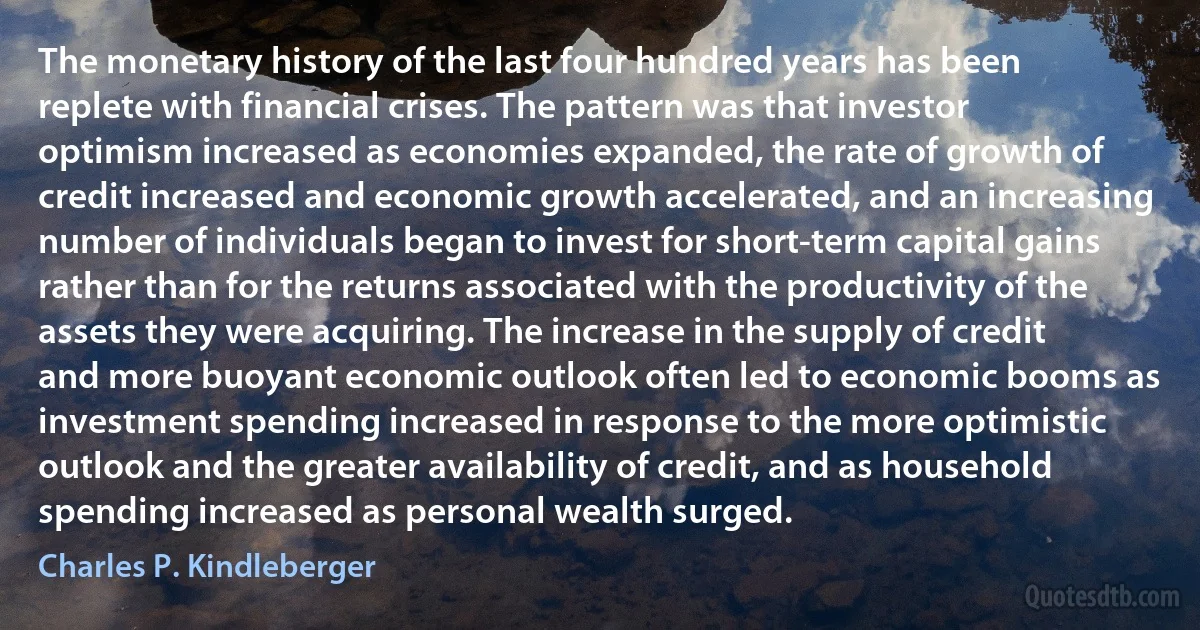
The monetary history of the last four hundred years has been replete with financial crises. The pattern was that investor optimism increased as economies expanded, the rate of growth of credit increased and economic growth accelerated, and an increasing number of individuals began to invest for short-term capital gains rather than for the returns associated with the productivity of the assets they were acquiring. The increase in the supply of credit and more buoyant economic outlook often led to economic booms as investment spending increased in response to the more optimistic outlook and the greater availability of credit, and as household spending increased as personal wealth surged.
Charles P. KindlebergerRelated topics
acquiring assets availability begin credit four history hundred increasing increase investor last led number outlook productivity replete spending wealth years returnsRelated quotes
Capitalism subordinates men to machines instead of using machines to liberate men from the burden of mechanical and repetitive work. it subordinates all, inherent in every commodity, fully unfolds itself in this contradictory nature of capitalist machinery. When capitalism is not overthrown once it has created the material and social preconditions for a classless society of associated producers, this contradiction implies the possibility of a steadily increasing transformation of the forces of production into forces of destruction, in the most literal sense of the word: not only forces of destruction of wealth (crises and wars), of human wealth and human happiness, but also forces of destruction of life tout court.

Ernest Mandel
It was a global depression, had many causes, the whole story requires you to look at the whole international system. But policy errors in United States, as well as abroad, did play an important role. And in particular as I said, the Federal Reserve failed in this first challenge in both parts of its mission. It did not use monetary policy aggressively to prevent deflation and the collapse in the economy, so it failed in its economic stability function. And it didn't adequately perform its function as lender of last resort allowing many bank failures and a resulting contraction in credit and also with the money supply. So, in that respect, again, the Fed did not fulfill its intended mission.

Ben Bernanke
I'm very aware that this programme may be regarded as bleak or depressing - an increasing population with an ever decreasing supply of resources – but humans have capabilities that animals don't: to think rationally; to study; to plan ahead. The number of people on the planet depends on the personal decisions we each make regarding the number of children we have even setting aside the moral responsibility we have to protect other species, if we continue to damage our ecosystem, we damage ourselves. Its clear that we'll have to change the way that we live and use our resources. We're at a crossroads where we can chose to cooperate or carry on regardless. Can our intelligence save us? I hope so. m46s24-m47s15.

David Attenborough
How could such industries as software, semiconductors, and computers have been so innovative despite historically weak patent protection? We argue that if innovation is both sequential and complementary-as it certainly has been in those industries-competition can increase firms' future profits thus offsetting short-term dissipation of rents. A simple model also shows that in such a dynamic industry, patent protection may reduce overall innovation and social welfare. The natural experiment that occurred when patent protection was extended to software in the 1980's provides a test of this model. Standard arguments would predict that R&D intensity and productivity should have increased among patenting firms.

Eric Maskin
Why... are there any market transactions at all? Why not all production carried on by one big firm?... First, as a firm gets larger, there may be decreasing returns to the entrepreneur function, that is, the costs of organizing additional transactions within the firm may rise... Second, it may be that as the transactions which are organized increase, the entrepreneur fails to place the factors of production in the uses where their value is greatest, that is, fails to make the best use of the factors of production... Finally, the supply price of one or more of the factors of production may rise, because the "other advantages" of a small firm are greater than those of a large firm.

Ronald Coase
